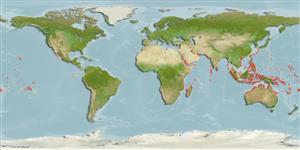Classification / Names
ชื่อสามัญ | ชื่อพ้อง | Catalog of Fishes(สกุล, ชนิด) | ITIS | CoL | WoRMS | Cloffa
Environment: milieu / climate zone / depth range / distribution range
นิเวศวิทยา
เกี่ยวกับทะเล,น้ำเค็ม เกี่ยวกับหินโสโครก; ระดับความลึก 0 - 3 m (Ref. 86942). Tropical; 32°N - 24°S
Indo-Pacific: Red Sea to the Marshall Islands, north to southern Japan, south to the southern Great Barrier Reef and New Caledonia; throughout Micronesia.
ขนาด / น้ำหนัก / Age
Maturity: Lm ? range ? - ? cm
Max length : 40.0 cm SL เพศผู้/กระเทย; (Ref. 1602); common length : 20.0 cm SL เพศผู้/กระเทย; (Ref. 9812)
เงี่ยงครีบหลัง (รวม): 4; ก้านครีบอ่อนที่หาง (รวม): 9-10; เงี่ยงครีบก้น 3; ก้านครีบอ่อนที่ก้น: 9. Olive dorsally; silvery ventrally (Ref. 9812).
Occur in coastal waters, mainly in reef flats and shallow lagoon reefs; often in silty habitats Form schools at the surface (Ref. 9710, 48637). Usually swimming in surface waters near freshwater run-offs. Oviparous, eggs are pelagic and non-adhesive (Ref. 205). Used as live bait in pole-and-line tuna fishing (Ref. 9812).
Life cycle and mating behavior
วัยเจริญพันธุ์ | การสืบพันธุ์ | การวางไข่ | เซลสืบพันธ์ของเพศเมีย(ไข่) | ความดกของไข่ | ตัวอ่อน
Myers, R.F., 1991. Micronesian reef fishes. Second Ed. Coral Graphics, Barrigada, Guam. 298 p. (Ref. 1602)
IUCN Red List Status (Ref. 130435)
Threat to humans
Harmless
Human uses
การประมง: ไม่มีผลประโยชน์; เหยื่อ: usually
ข้อมูลเพิ่มเติม
ชื่อสามัญชื่อพ้องกลไกการเผาผลาญพลังงานผู้ล่าการศึกษาเกี่ยวกับผลกระทบของสารประกอบทางเคมีที่เป็นอันตรายต่อสิ่งมีชีวิต ประชากร และสิ่งแวดล้อมการสืบพันธุ์วัยเจริญพันธุ์การวางไข่การรวมกลุ่มวางไข่ความดกของไข่เซลสืบพันธ์ของเพศเมีย(ไข่)Egg development
อ้างอิงการเพาะเลี้ยงสัตว์น้ำประวัติการเพาะเลี้ยงสัตว์น้ำสายพันธุ์พันธุศาสตร์ElectrophoresesอัตราพันธุกรรมโรคการแปรรูปNutrientsMass conversion
ผู้ร่วมมือรูปภาพหลายรูปStamps, Coins Misc.เสียงปลามีพิษ เช่น ปลาปักเป้าความเร็วรูปแบบการว่ายน้ำพื้นที่เหงือกOtolithsสมองวิสัยทัศน์
เครื่องมือ
Special reports
Download XML
แหล่งที่มาจากอินเตอร์เน็ต
Estimates based on models
Preferred temperature (Ref.
123201): 25.2 - 29.3, mean 28.5 °C (based on 2805 cells).
Phylogenetic diversity index (Ref.
82804): PD
50 = 1.0000 [Uniqueness, from 0.5 = low to 2.0 = high].
Bayesian length-weight: a=0.00977 (0.00600 - 0.01591), b=2.89 (2.75 - 3.03), in cm total length, based on LWR estimates for this species & (Sub)family-body (Ref.
93245).
ระดับชั้นอาหาร (Ref.
69278): 2.4 ±0.2 se; based on size and trophs of closest relatives
ความสามารถในการกลับคืนสู่ปกติ (Ref.
120179): ขนาดกลาง, เวลาต่ำสุดที่จะทำให้ประชากรเพิ่มขึ้นเป็น 2 เท่าใช้เวลา 1.4 - 4.4 ปี (Preliminary K or Fecundity.).
Fishing Vulnerability (Ref.
59153): Moderate vulnerability (39 of 100).
Nutrients (Ref.
124155): Calcium = 63.8 [25.1, 220.1] mg/100g; Iron = 0.664 [0.291, 1.741] mg/100g; Protein = 18.6 [16.6, 20.4] %; Omega3 = 0.136 [0.063, 0.299] g/100g; Selenium = 21 [10, 53] μg/100g; VitaminA = 74.7 [14.1, 323.0] μg/100g; Zinc = 1.81 [1.14, 2.76] mg/100g (wet weight);
